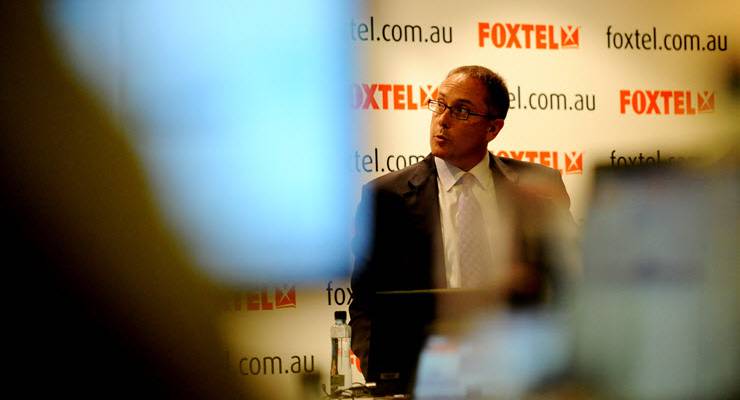
Pay television came late to Australia. It never had deep penetration, and now it’s all but vanishing in the face of changing watching habits accelerated by the COVID-19 crisis.
Like Wile E. Coyote, it’s out over the canyon, pedalling hard at thin air to stay aloft.
Pay TV has always faced an unavoidable constraint on human activity: we can only watch one television show at a time. But in Australia, its end has been hurried on by News Corp’s long term determination to have monopoly control through Foxtel.
By 2019, company figures suggest take-up was down to about one in five households. In the US cable still connects more than half of all households, down from about two-thirds in 2000.
COVID-19 is hitting Foxtel every which way. With bars and clubs closed, it’s lost critical revenues from commercial subscriptions. Cash-hit households are reviewing discretionary expenditures, and advertising is being hammered.
Just before Easter, Foxtel sacked 200 staff and sent another 140 on leave.
The shock has stymied the company’s pivot to streaming, with Foxtel Now (for drama) and Kayo (for sport).
Our changing habits are driving the shift, as highlighted in last week’s options paper on media regulation released by the federal government.
Since the launch of Netflix and Stan in Australia, eyeballs on so-called “linear TV” — both free-to-air and pay — have been sliding. Commercial TV is down 10 points to 75% of adult audiences. Pre-COVID-19 ad revenue has followed it down, about 7.5% on the three networks’ pre-Netflix peak. It’s estimated to be down a further 30% right now.
It’s bad, but the networks reckon they can reset at a lower level. As Crikey reported last week, that’s behind both the broadcast punch-up over rugby league restarting and the government’s media bailout.
Foxtel is significantly weaker, with its residential pay-tv subscriptions less than half those of Netflix. Now revenues look like they’re also falling behind the streaming giant, earlier than expected.
It’s been 20-odd years coming, ever since the company decided it would rather have Foxtel as a cash-cow monopoly than a competitor in a larger market. News Corp vertically integrated to control both distribution (through its cables and set-top boxes) and programming (through channel ownership of Fox Sport and now Sky).
It blocked competitors by declining to carry an early iteration of an ABC-backed news channel or a Kerry Stokes-backed sports channel. It spent money to buy audiences, including $100 million-plus on the breakaway Super League.
Foxtel was always richly priced (its “platinum plus” full package is still $139 per month). Between Australia’s free offering on commercial and public broadcasting and the DVD boomlet, it never reached more than 30% of Australian households.
As a result, News Corp could never persuade successive governments to remove the poison pill left by the Keating government: so-called anti-siphoning laws which prevented them buying exclusive rights to major sports — the strategy that drove subscription broadcasting in the UK and the US.
News Corp has seen this coming. It tried to postpone the day of reckoning once by campaigning against the NBN.
After the UK hacking scandal forced the Murdochs to split their print and broadcast interests in 2013, Foxtel was left behind in the print-based News Corp. Pity. If it had been otherwise, the company would now be safely lost in the Disney behemoth like, say, Star India.
Instead, in the much smaller News Corp the rescue plan was to merge Foxtel (50-50 owned with Telstra) with the wholly-owned Fox Sports and float the new Foxtel on the ASX. The merger went ahead in 2018, giving News 65%, but all talk of a float has dissipated.
Foxtel’s streaming pivot has struggled to compete on price and on UX, despite its strong drama product (as a result of a tie-up with US prestige channel HBO). The summer bushfires got in the way of a cricket-driven kick start of Kayo. Then the winter football codes were stopped by COVID-19.
The moral? The insistence on monopoly made pay TV in Australia nothing more than a transitional technology.
With the plethora of choice from over-the-top streaming, it won’t be missed.









The sooner any part of the Murdoch empire withers and dies, the better.
I’m still shocked that anyone pays $139 a month for television.
I have Foxtel Now, but only because of the HBO content. The death of Foxtel can’t come soon enough.
Who mourns the passing of a tapeworm?
Any story on at the decline of any News Corp business on Crikey inevitably attracts only one response from its readers: “Hooray! Hallelujah! Can I be the first to spit on its grave!!”
Here’s what those people are celebrating –
– Unemployment for journalists, knowledge workers and support staffers – all of whom (once) paid taxes in Australia.
– The collapse of local supply line businesses – printers, mechanics, media technicians, camera operators, paper manufacturers, delivery drivers, baristas (yes, journos and tv crews drink lots of coffee)…
– a dramatic decline in incomes for other knowledge workers too – graphic artists, photographers, illustrators, writers, book reviewers, freelance specialists… all locals, all who (once) paid taxes in this country…
– and all those people once employed by said hated organisation, directly and indirectly, have families, who were also able to support local business. All gone…
Yet I still hear cheers in the Crikey Bunker…. But why? The victors in this the destruction of local businesses are you know who – Google and Facebook. Who employ almost no one in Australia and pay even less tax.
Hip, hip…hoo (oops, hang on…)
Yup – except I wouldn’t waste the spit.
Could have been worse – just imagine how many people would have been effected if successive governments hadn’t kowtowed to the Murdoch regime’s rentier schemes, and actually promoted a little ‘competitive tension’.
And, don’t forget, Goebbels also employed a lot of ‘journalists and knowledge workers’, and Germany came out of that period OK.
Nah, that’s not we’re celebrating. Stop with the misdirection, leave the blame squarely with Uncle Phone Hacker. Where it belongs.
… Remember how Murdoch’s Muppets have mourned the passing of other industries – or how they’ve treated unions/workers?
So how do we continue to support and resurrect our media, local arts, film, music, drama industries as well as have robust audience drawing commercial TV, radio and print in the face of a dying but still potent Merde Orc monopoly? The good old days of rural, regional and metro well staffed newsrooms are gone forever as stolen news goes online whether Google, FB or other players pay taxes or not. As CW listed Foxtel’s death throes have been coming a long time thru cost (plus its use as a Fox extremist propaganda channel). As Turnbull says ensuring the PM/government were his was Ruperts focus above all else. There must be repercussions for this abuse of power. RC anyone? As the same time what does the future hold for mostly still dying Oz journalism? How do we ensure a healthy independent media and not a propaganda or business marketing tool?